gas type Alfa Romeo Giulia 2019 Owner's Manual
[x] Cancel search | Manufacturer: ALFA ROMEO, Model Year: 2019, Model line: Giulia, Model: Alfa Romeo Giulia 2019Pages: 232, PDF Size: 4.87 MB
Page 136 of 232
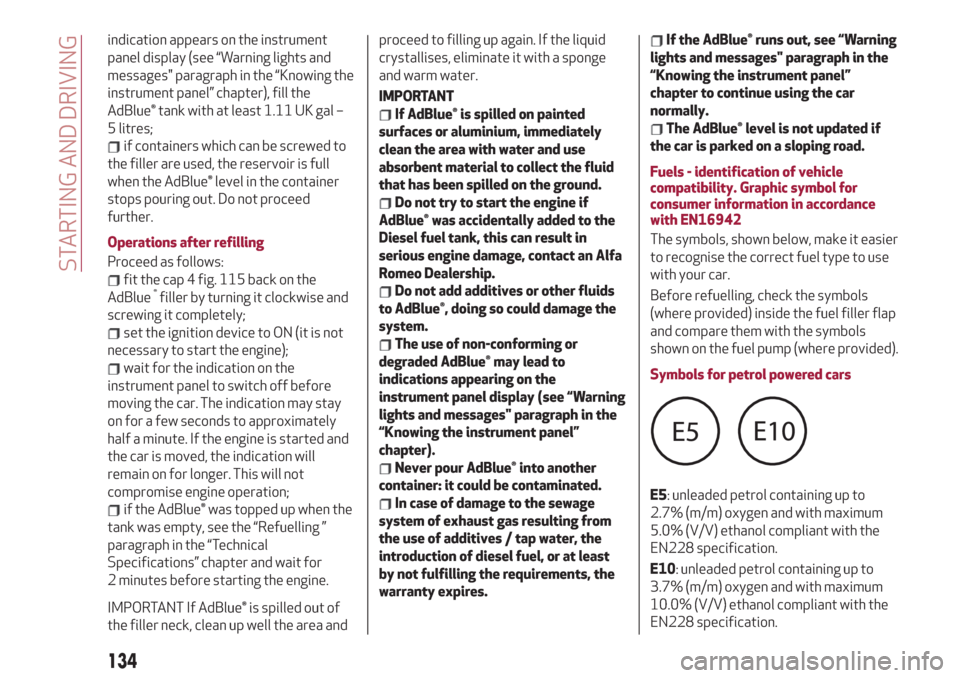
indication appears on the instrument
panel display (see “Warning lights and
messages" paragraph in the “Knowing the
instrument panel” chapter), fill the
AdBlue® tank with at least 1.11 UK gal –
5 litres;
if containers which can be screwed to
the filler are used, the reservoir is full
when the AdBlue® level in the container
stops pouring out. Do not proceed
further.
Operations after refilling
Proceed as follows:
fit the cap 4 fig. 115 back on the
AdBlue®filler by turning it clockwise and
screwing it completely;
set the ignition device to ON (it is not
necessary to start the engine);
wait for the indication on the
instrument panel to switch off before
moving the car. The indication may stay
on for a few seconds to approximately
half a minute. If the engine is started and
the car is moved, the indication will
remain on for longer. This will not
compromise engine operation;
if the AdBlue® was topped up when the
tank was empty, see the “Refuelling ”
paragraph in the “Technical
Specifications” chapter and wait for
2 minutes before starting the engine.
IMPORTANT If AdBlue® is spilled out of
the filler neck, clean up well the area andproceed to filling up again. If the liquid
crystallises, eliminate it with a sponge
and warm water.
IMPORTANT
If AdBlue® is spilled on painted
surfaces or aluminium, immediately
clean the area with water and use
absorbent material to collect the fluid
that has been spilled on the ground.
Do not try to start the engine if
AdBlue® was accidentally added to the
Diesel fuel tank, this can result in
serious engine damage, contact an Alfa
Romeo Dealership.
Do not add additives or other fluids
to AdBlue®, doing so could damage the
system.
The use of non-conforming or
degraded AdBlue® may lead to
indications appearing on the
instrument panel display (see “Warning
lights and messages" paragraph in the
“Knowing the instrument panel”
chapter).
Never pour AdBlue® into another
container: it could be contaminated.
In case of damage to the sewage
system of exhaust gas resulting from
the use of additives / tap water, the
introduction of diesel fuel, or at least
by not fulfilling the requirements, the
warranty expires.
If the AdBlue® runs out, see “Warning
lights and messages" paragraph in the
“Knowing the instrument panel”
chapter to continue using the car
normally.
The AdBlue® level is not updated if
the car is parked on a sloping road.
Fuels - identification of vehicle
compatibility. Graphic symbol for
consumer information in accordance
with EN16942
The symbols, shown below, make it easier
to recognise the correct fuel type to use
with your car.
Before refuelling, check the symbols
(where provided) inside the fuel filler flap
and compare them with the symbols
shown on the fuel pump (where provided).
Symbols for petrol powered cars
E5: unleaded petrol containing up to
2.7% (m/m) oxygen and with maximum
5.0% (V/V) ethanol compliant with the
EN228 specification.
E10: unleaded petrol containing up to
3.7% (m/m) oxygen and with maximum
10.0% (V/V) ethanol compliant with the
EN228 specification.
134
STARTING AND DRIVING
Page 143 of 232
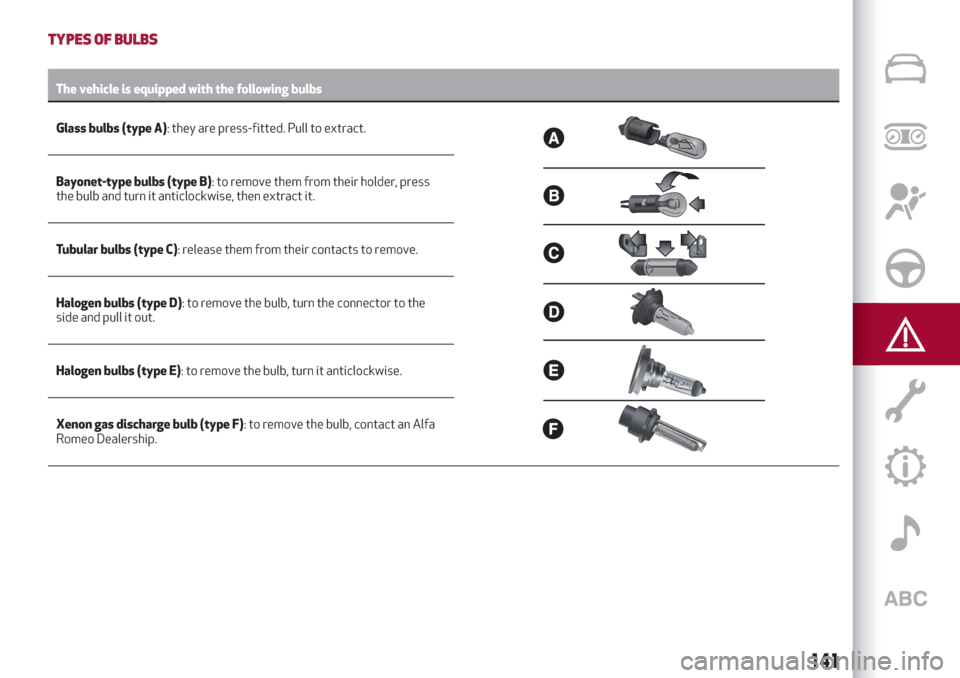
TYPES OF BULBS
The vehicle is equipped with the following bulbs
Glass bulbs (type A): they are press-fitted. Pull to extract.
Bayonet-type bulbs (type B): to remove them from their holder, press
the bulb and turn it anticlockwise, then extract it.
Tubular bulbs (type C): release them from their contacts to remove.
Halogen bulbs (type D): to remove the bulb, turn the connector to the
side and pull it out.
Halogen bulbs (type E): to remove the bulb, turn it anticlockwise.
Xenon gas discharge bulb (type F): to remove the bulb, contact an Alfa
Romeo Dealership.
141
Page 144 of 232
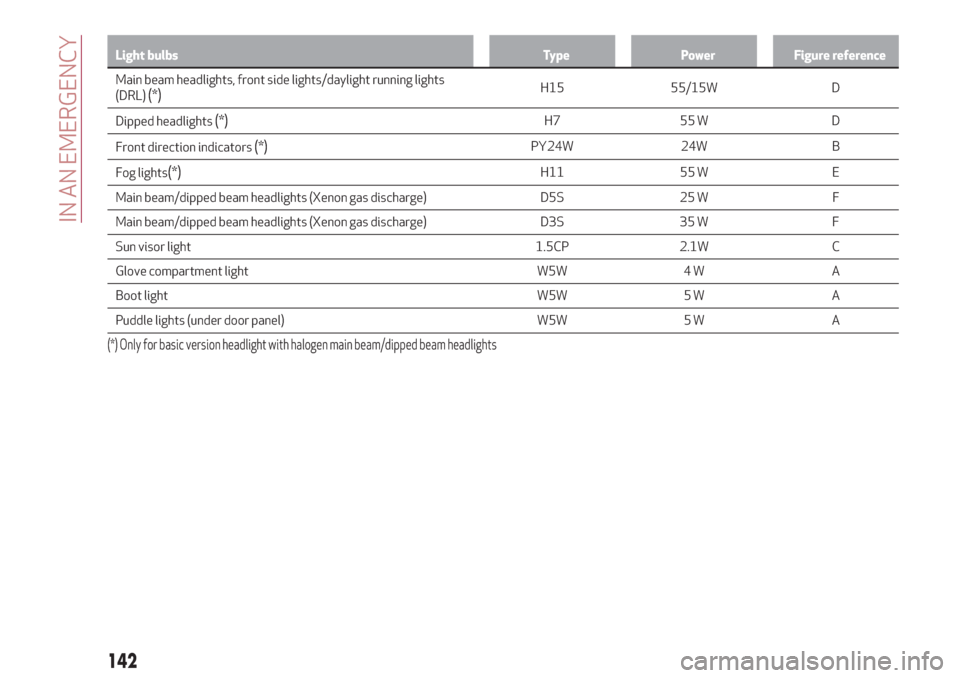
Light bulbs Type Power Figure reference
Main beam headlights, front side lights/daylight running lights
(DRL)(*)H15 55/15W D
Dipped headlights
(*)H7 55 W D
Front direction indicators
(*)PY24W 24W B
Fog lights
(*)H11 55 W E
Main beam/dipped beam headlights (Xenon gas discharge) D5S 25 W F
Main beam/dipped beam headlights (Xenon gas discharge) D3S 35 W F
Sun visor light 1.5CP 2.1W C
Glove compartment light W5W 4 W A
Boot light W5W 5 W A
Puddle lights (under door panel) W5W 5 W A
(*) Only for basic version headlight with halogen main beam/dipped beam headlights
142
IN AN EMERGENCY
Page 174 of 232
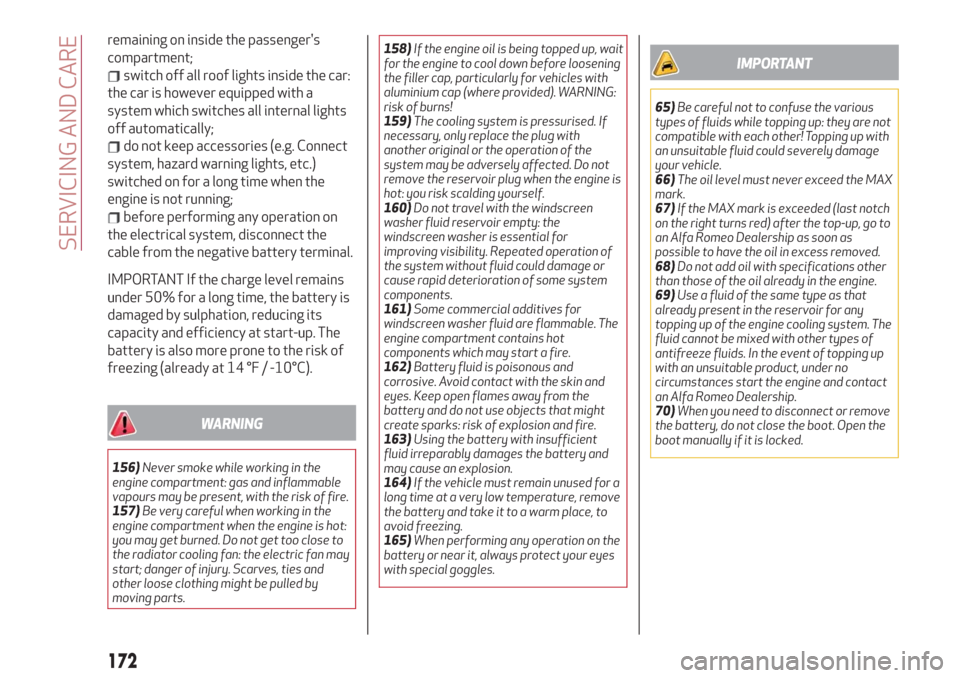
remaining on inside the passenger's
compartment;
switch off all roof lights inside the car:
the car is however equipped with a
system which switches all internal lights
off automatically;
do not keep accessories (e.g. Connect
system, hazard warning lights, etc.)
switched on for a long time when the
engine is not running;
before performing any operation on
the electrical system, disconnect the
cable from the negative battery terminal.
IMPORTANT If the charge level remains
under 50% for a long time, the battery is
damaged by sulphation, reducing its
capacity and efficiency at start-up. The
battery is also more prone to the risk of
freezing (already at 14 °F / -10°C).
WARNING
156)Never smoke while working in the
engine compartment: gas and inflammable
vapours may be present, with the risk of fire.
157)Be very careful when working in the
engine compartment when the engine is hot:
you may get burned. Do not get too close to
the radiator cooling fan: the electric fan may
start; danger of injury. Scarves, ties and
other loose clothing might be pulled by
moving parts.158)If the engine oil is being topped up, wait
for the engine to cool down before loosening
the filler cap, particularly for vehicles with
aluminium cap (where provided). WARNING:
risk of burns!
159)The cooling system is pressurised. If
necessary, only replace the plug with
another original or the operation of the
system may be adversely affected. Do not
remove the reservoir plug when the engine is
hot: you risk scalding yourself.
160)Do not travel with the windscreen
washer fluid reservoir empty: the
windscreen washer is essential for
improving visibility. Repeated operation of
the system without fluid could damage or
cause rapid deterioration of some system
components.
161)Some commercial additives for
windscreen washer fluid are flammable. The
engine compartment contains hot
components which may start a fire.
162)Battery fluid is poisonous and
corrosive. Avoid contact with the skin and
eyes. Keep open flames away from the
battery and do not use objects that might
create sparks: risk of explosion and fire.
163)Using the battery with insufficient
fluid irreparably damages the battery and
may cause an explosion.
164)If the vehicle must remain unused for a
long time at a very low temperature, remove
the battery and take it to a warm place, to
avoid freezing.
165)When performing any operation on the
battery or near it, always protect your eyes
with special goggles.
IMPORTANT
65)Be careful not to confuse the various
types of fluids while topping up: they are not
compatible with each other! Topping up with
an unsuitable fluid could severely damage
your vehicle.
66)The oil level must never exceed the MAX
mark.
67)If the MAX mark is exceeded (last notch
on the right turns red) after the top-up, go to
an Alfa Romeo Dealership as soon as
possible to have the oil in excess removed.
68)Do not add oil with specifications other
than those of the oil already in the engine.
69)Use a fluid of the same type as that
already present in the reservoir for any
topping up of the engine cooling system. The
fluid cannot be mixed with other types of
antifreeze fluids. In the event of topping up
with an unsuitable product, under no
circumstances start the engine and contact
an Alfa Romeo Dealership.
70)When you need to disconnect or remove
the battery, do not close the boot. Open the
boot manually if it is locked.
172
SERVICING AND CARE
Page 176 of 232

to measure the charge and discharge
voltage and calculate the charge level
and the general condition of the battery.
The sensor is placed next to the negative
terminal (-) of the battery.
For a correct charge/discharge
procedure, the charge voltage must go
through the IBS sensor.
Turn the charger on and follow the
instructions on the user's manual to
completely recharge the battery;
when the battery is charged, turn the
charger off before disconnecting it from
the battery;
first disconnect the black cable
terminal of the battery charger and then
the red cable terminal;
refit the protective cover of the
positive terminal of the battery and the
access cover to the battery
compartment.
IMPORTANT If a "quick-type" battery
charger is used with the battery fitted on
the vehicle, before connecting it
disconnect both cables of the battery
itself. Do not use a "quick-type" battery
charger to provide the starting voltage.
71)
WARNING
166)The process of charging or recharging
the battery produces hydrogen, a flammable
gas that can explode and cause serious
injury.
167)When charging or recharging the
battery, always follow the precautions
listed.
IMPORTANT
71)When you need to disconnect or remove
the battery, do not close the boot. Open the
boot manually if it is locked.
SERVICING PROCEDURES
168) 169) 170)
72) 73) 74) 75) 76) 77) 78)
AIR CONDITIONINGSYSTEM
MAINTENANCE
79) 80)
To ensure the best possible performance,
the air conditioning system must be
checked and undergo maintenance at an
Alfa Romeo Dealership at the beginning
of the summer.
WINDSCREEN WIPER
Raising the windscreen wiper blades
("Service position" function)
The "Service position" function allows the
driver to replace the windscreen wiper
blades more easily. It is also
recommended to activate this function
when it is snowing and to make it easier
to remove any dirt deposits in the area
where the blades are normally
positioned, when washing.
Activation of the function
To activate this function, deactivate the
windscreen wiper (ring nut fig. 158 in
positionO) before setting the ignition
device to STOP.
174
SERVICING AND CARE
Page 181 of 232
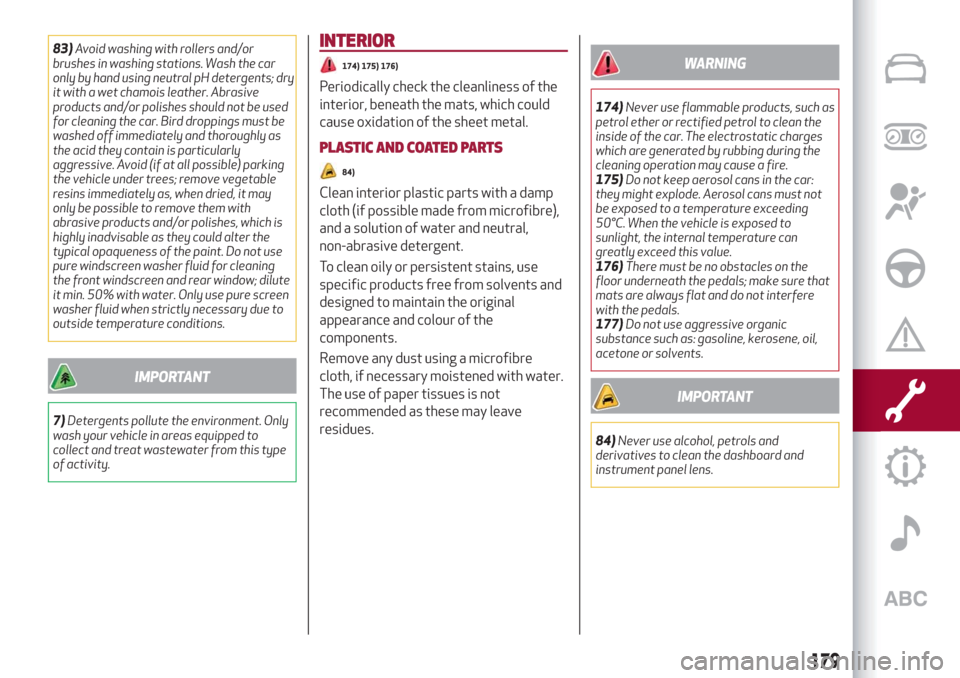
83)Avoid washing with rollers and/or
brushes in washing stations. Wash the car
only by hand using neutral pH detergents; dry
it with a wet chamois leather. Abrasive
products and/or polishes should not be used
for cleaning the car. Bird droppings must be
washed off immediately and thoroughly as
the acid they contain is particularly
aggressive. Avoid (if at all possible) parking
the vehicle under trees; remove vegetable
resins immediately as, when dried, it may
only be possible to remove them with
abrasive products and/or polishes, which is
highly inadvisable as they could alter the
typical opaqueness of the paint. Do not use
pure windscreen washer fluid for cleaning
the front windscreen and rear window; dilute
it min. 50% with water. Only use pure screen
washer fluid when strictly necessary due to
outside temperature conditions.
IMPORTANT
7)Detergents pollute the environment. Only
wash your vehicle in areas equipped to
collect and treat wastewater from this type
of activity.
INTERIOR
174) 175) 176)
Periodically check the cleanliness of the
interior, beneath the mats, which could
cause oxidation of the sheet metal.
PLASTIC AND COATED PARTS
84)
Clean interior plastic parts with a damp
cloth (if possible made from microfibre),
and a solution of water and neutral,
non-abrasive detergent.
To clean oily or persistent stains, use
specific products free from solvents and
designed to maintain the original
appearance and colour of the
components.
Remove any dust using a microfibre
cloth, if necessary moistened with water.
The use of paper tissues is not
recommended as these may leave
residues.
WARNING
174)Never use flammable products, such as
petrol ether or rectified petrol to clean the
inside of the car. The electrostatic charges
which are generated by rubbing during the
cleaning operation may cause a fire.
175)Do not keep aerosol cans in the car:
they might explode. Aerosol cans must not
be exposed to a temperature exceeding
50°C. When the vehicle is exposed to
sunlight, the internal temperature can
greatly exceed this value.
176)There must be no obstacles on the
floor underneath the pedals; make sure that
mats are always flat and do not interfere
with the pedals.
177)Do not use aggressive organic
substance such as: gasoline, kerosene, oil,
acetone or solvents.
IMPORTANT
84)Never use alcohol, petrols and
derivatives to clean the dashboard and
instrument panel lens.
179